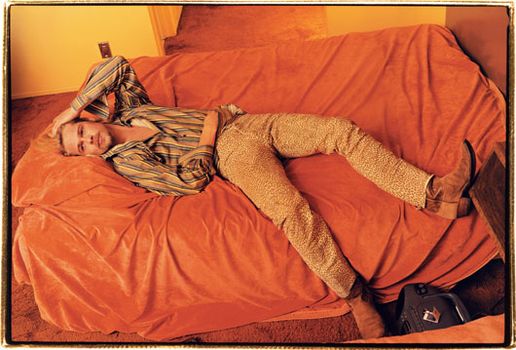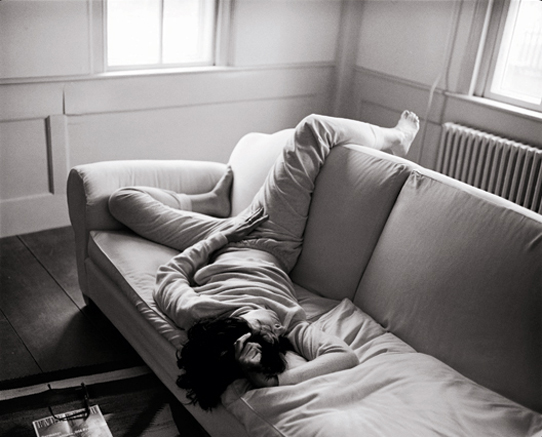I remember sitting in a photography seminar aged around 19 and going out of my mind as the lecturer scanned through hundreds of slides. It was in this class that one particular image changed my whole passion for photography. It was taken by Annie Liebovitz; a picture of a naked John Lennon embracing a fully clothed Yoko Ono on the bedroom floor of a hotel room. The image alone was spectacular. My interest grew even further when learning that he was killed only a few hours after the portrait was taken which further heightened the emotion of the image. I needed to see more….

Annie Liebovitz is a photographer who grew up in a close-knit family in America. From a young age she was subjected to a life on the road; her father a military man who moved his family around every 1 to 2 years. Through this lifestyle Annie was living a fuller life than most children of her age and framed every passing moment through the window of the family car. Annie first got into photography in the late sixties; she studied at the San Francisco Art Institute where personal reportage was a prominent element of the curriculum.

Annie spent some time living in a Kibbutz in Israel in 1969 before being drawn back to the States by the huge anti-war demonstrations happening in Berkeley and San Francisco. One of her pictures found it to the cover of Rolling Stone Magazine where she later took her first professional role. Rolling Stone was considered a music magazine with heavy political undertones. Here she was warmly adopted into a vibrant and lively community of artists, journalists and intense characters during the repercussions of the civil rights movements and death of the American Dream. Annie became the chief photographer by 1973 and threw herself into whatever was going on at the magazine, she believed she was to capture life as it was; she was invisible; a fly on the wall. Further still she didn’t always take the obvious shot or follow the assignment but would always come back with a cover shot, a photograph that told a story, that pictured the emotion of the subject.
Through her style Annie managed to honestly capture the culture of a whole generation, shooting 143 covers in her 10 years at Rolling Stone.

In her time with the magazine, she became a close acquaintance of Hunter S Thompson who was writing for Rolling Stone as a journalist. An interesting relationship grew between them; HST interviewed for a documentary in 1993 states
“…She was a photographer 25 hours a day, it was intolerable! I nearly threw all of her film and her Hasselblad into the fireplace…”.

Whilst the two didn’t particularly share the same work ethic they did spend some time together. At one of these meetings Annie somehow ended up in the car with HST out near his Woody Creek home on a serious mescaline bender. The trademark erratic driving caught the attention of the police who pulled them over. Sensing a serious situation and being pushed around by the police HST desperately called upon Annie to photograph the scene at which point the police got nervous and quickly disappeared.

From Rolling Stone to the Rolling Stones… In 1975 Annie was approached by Mick Jagger who asked her to be the tour photographer for the Rolling Stones. In her peak, editor Jann Wenner couldn’t afford to lose his number one photographer for such a period of time and tried calling Annie’s bluff by stating that in taking this role there would be no role for her at the magazine upon return.
Annie wasn’t at all tour experienced, packing a tennis racquet which was much to the humour of Keith Richards. Her interest in just photographing the energy exerted by the band on stage soon loosened to include the equally intense energy of the audience. These crowd photos remain favourites for Mick Jagger authenticating just how much the audience gave themselves up to the music in this period.

As time passed on the tour Annie became one of the boys and the photography went a lot deeper and darker. She started to de-romanticise the glamour of tour life, detailing the carnage and strains that the tour had on the body. Mick Jagger states that she was by this stage
“…not a fly on the wall type…”
confirming the changes in her usual presence. She was involved in everything the band were doing both on-stage and back-stage. Annie herself states that
“… to get the best work you have to be totally involved… I almost lost my soul…. I allowed myself to go on something so deeply that I let it overtake me…”.
This tour was almost the end for Annie as she allowed herself to become consumed by the lifestyle that she was documenting.


Gaining recognition in her career Annie found herself more visible and people started asking what they were meant to be doing, posing for their photo before a chance was had for a natural shot! Developing her skill in portrait photography she soon kicked off the next chapter in her career; a PR weapon of the Eighties. In 1981 Annie Liebovitz began working for Vanity Fair magazine which like Rolling Stone was in its infancy when she joined. This was a magazine that aimed at a different audience, one of wealth and power. Here she shot the portraits of celebrities in a new glamourous light; part of a public relations machine boosting the image of the stars. The manner in which she shot her subject was however far from traditional, pushing the norm, and incredibly effective in giving a true sense of personality.
What any normal photographer sent to take photos of Keith Haring would capture is something that looks a little like the below and this is the image that Vanity Fair magazine were probably expecting in 1986:
Though pushing the taboo to the limit as much as the subject, Annie convinced Keith to BE the art. He instead finished the piece, removed his clothes and continued to paint himself into the shot.

Thinking that this was perhaps the limit Annie pushed it further still having Keith agree to take it into the city streets where further pictures exist of what I’m sure on-lookers would never forget.







The above photos display a vast diversity in her portfolio with a notable statement once made that you’re not famous UNTIL you’ve been shot by Annie.
Later Life:
Annie has continued to shoot as a free-lance photographer for Vanity Fair Magazine. She has photographed hundreds of celebrities causing her fair share of controversy over the years. She has claimed however to never really like the word “celebrity”.
“I’ve always been more interested in what they do than who they are; I hope that my photographs reflect that.”
She has also been known to shoot for Vogue magazine, recently photographing a somewhat talked about cover and editorial of Kim Kardashian West and Kanye West with their daughter North.
Over her extensive career she has released 11 books. One of the better examples of her early work would be ‘Photographs’ 1970–1990. This book is a truly stunning collection of pictures, which all being shot in film gives it a really raw feel that I love. Anther one of her books I really adore was ‘A Photographer’s Life’ 1990–2005. This book is a tribute to Leibovitz’s relationship with her best friend and lover, Susan Sontag, who died in 2004. The 300 page book tells a love story and a tale of a photographers life. It documents events occurring within her large family, the birth of her three daughters; and sadly, the death of her father. You will find amongst the photos of her life; portraits of public figures and famous faces and an essay written by Annie.


She now has a new publication out, a book called pilgrimage. Annie has chosen an entirely new subject, The homes of Charles Darwin, Virginia Woolf, Emily Dickinson, and Sigmund Freud as she wanted to capture the spaces where her intellectual heroes had once lived.


